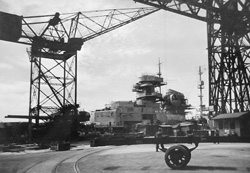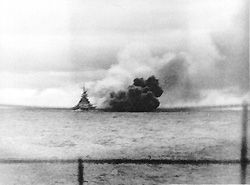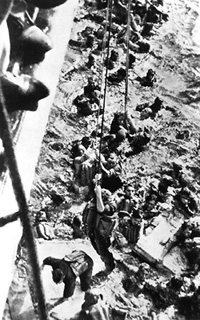Battleship Bismarck
During her service, the Bismarck was the flagship of the German Kriegsmarine, and with its sister-ship Tirpitz, the largest German warship ever built. Equipped with 38 cm and 15 cm guns, strong Flak armament and battle-tested resilient armor, the Bismarck represented the pinnacle of the evolution of battleships.
 On July 1st 1936, the construction of "Battleship F" at the Hamburg shipyard of Blohm & Voss begins. After 2 ½ years of construction work, the ship is launched and christened "Bismarck". One and one half more years of finishing work must be completed before the ship is commissioned and departs for her shake-down cruises on the Baltic Sea. Machinery and artillery are now subjected to tests and fully meet the requirements. Deficiencies are corrected, and combat scenarios are executed again and again. The crew is thoroughly trained for deployment and becomes an integral part of the ship itself.
On July 1st 1936, the construction of "Battleship F" at the Hamburg shipyard of Blohm & Voss begins. After 2 ½ years of construction work, the ship is launched and christened "Bismarck". One and one half more years of finishing work must be completed before the ship is commissioned and departs for her shake-down cruises on the Baltic Sea. Machinery and artillery are now subjected to tests and fully meet the requirements. Deficiencies are corrected, and combat scenarios are executed again and again. The crew is thoroughly trained for deployment and becomes an integral part of the ship itself.
Then, on 18 May 1941, all is ready. Bismarck, accompanied by the heavy cruiser Prinz Eugen, heads out to sea. From the very outset, however, the mission does not go according to plan. As early as the passage through the Belt on the way to Norway, the formation is discovered by the Norwegian underground and by British air reconnaissance. In London, all possible countermeasures are taken immediately to prevent their advance into the Atlantic since the Royal Navy is aware how much damage this formation could inflict on the vital convoys headed for Great Britain.
Nevertheless, the two ships continue their mission. Despite inclement weather, they are discovered by British cruisers on patrol in the Denmark Straits. The cruisers shadow the German formation. The HMS Hood and the HMS Prince of Wales were send by the Admiralty to engage the enemy.
The Royal Navy's attempt to stop the German thrust in the Denmark Straits fails dramatically. On 24 May, 1941, after just six minutes of combat, a shell from the Bismarck sets off a powerful explosion aboard HMS Hood, tearing her in half. Out of the crew of 1418 men only three survive. Severely damaged in the encounter, the HMS Prince of Wales breaks off contact.
 During the engagement, Bismarck is hit by a British salvo. The battle damage forces Admiral Lütjens to take steps to shorten Operation "Rheinübung." The evening of the same day, Bismarck is spotted by the US Coast Guard Cutter Modoc which then witnesses an aerial attack on Bismarck by torpedo planes from the carrier HMS Victorious. With the fate of the HMS Hood, the British do not dare surface attacks until sufficiently powerful ships can be brought in. Until then, aircraft are to attack the ship to slow it down.
During the engagement, Bismarck is hit by a British salvo. The battle damage forces Admiral Lütjens to take steps to shorten Operation "Rheinübung." The evening of the same day, Bismarck is spotted by the US Coast Guard Cutter Modoc which then witnesses an aerial attack on Bismarck by torpedo planes from the carrier HMS Victorious. With the fate of the HMS Hood, the British do not dare surface attacks until sufficiently powerful ships can be brought in. Until then, aircraft are to attack the ship to slow it down.
But then the totally unexpected occurs. Bismarck escapes from her stalkers and when she is relocated she is so far away from the concentrated warships that they have no hope of catching her before she reaches Brest in occupied France. Only the torpedo planes of the HMS Ark Royal stand between the Bismarck and the safety of the French port.
The Swordfish of the HMS Ark Royal attack her one final time. Shortly after 9 pm 26 May, she sustains a torpedo hit which jams her rudder assembly, crippling her. It is the Bismarck’s death sentence because she can no longer maneuver and actually heads back toward the approaching British Fleet.
 The crew of the Bismarck experience an agonizing night. The damage cannot be repaired, and it is certain that the ship will drift into the reach of the pursuing enemy who can take up positions for final battle at his leisure. It is now 27 May, 0848, as Bismarck opens fire for last time. The fire-control stations and the guns are soon struck and put out of commission, and Bismarck becomes a defenseless practice target for the British battleships.
The crew of the Bismarck experience an agonizing night. The damage cannot be repaired, and it is certain that the ship will drift into the reach of the pursuing enemy who can take up positions for final battle at his leisure. It is now 27 May, 0848, as Bismarck opens fire for last time. The fire-control stations and the guns are soon struck and put out of commission, and Bismarck becomes a defenseless practice target for the British battleships.
Shell after shell hit the decks from various heavy ships, destroying the superstructure and the guns and killing the men still at their stations and later those who are attempting to leave the ship. Nevertheless, the shells do not penetrate the armor and reach internal regions of the ship. Not until the scuttling charges are set off and Bismarck suffers a torpedo barrage, does she finally capsize.
86 men are rescued by the cruiser HMS Dorsetshire, 25 by the destroyer HMS Maori. The rescue action is broken off because of a U-Boat alarm which turned out to be false, leaving approximately 800 men to their fate in the sea. Five more men are saved by the U-74 and the weather ship Sachsenwald.
2,145 men go down with the ship. Other sources claim 2,371 men. 1.415 Royal Navy sailors die.
|